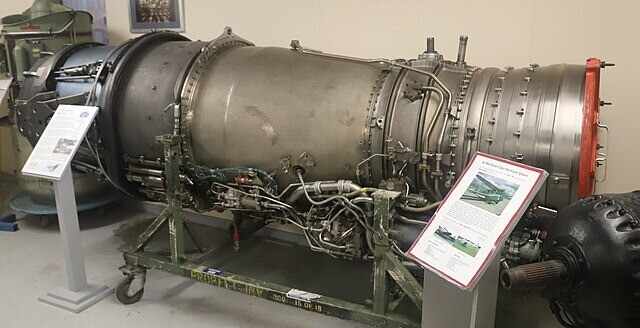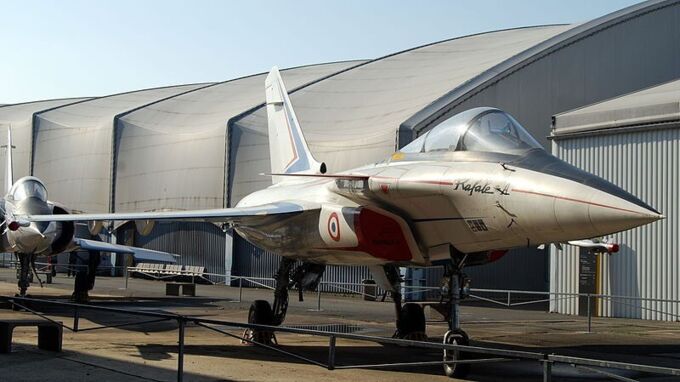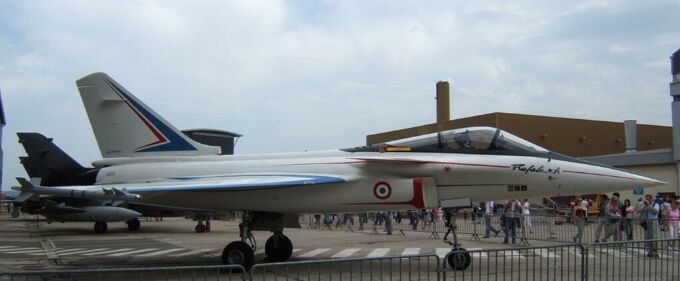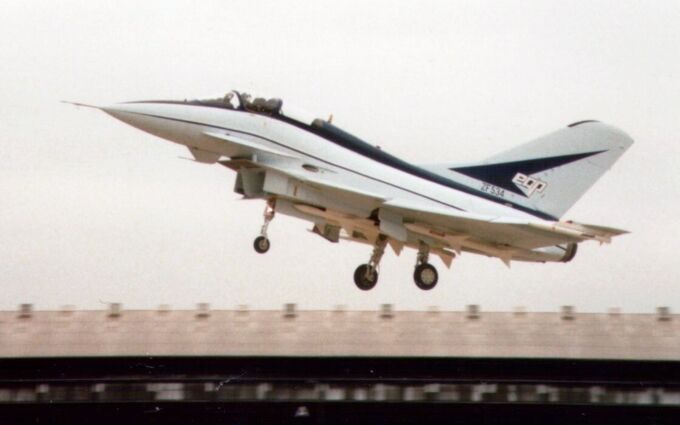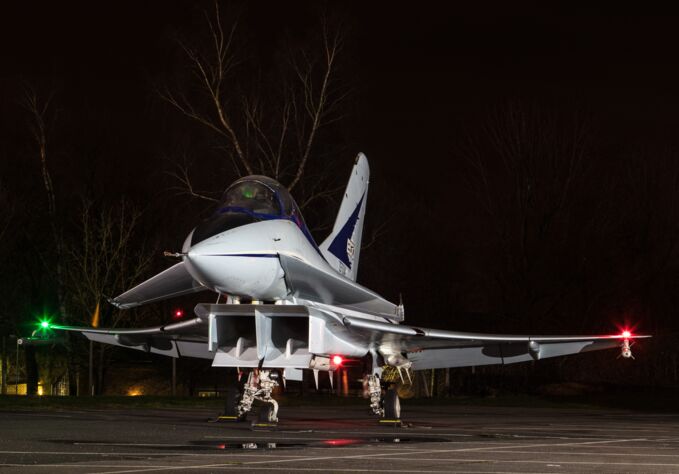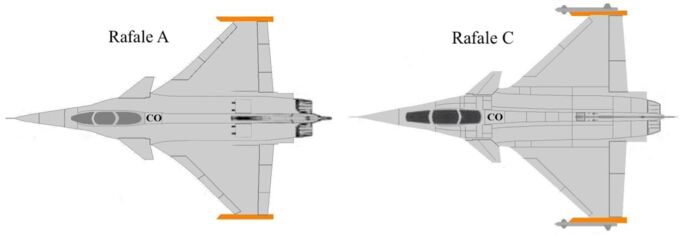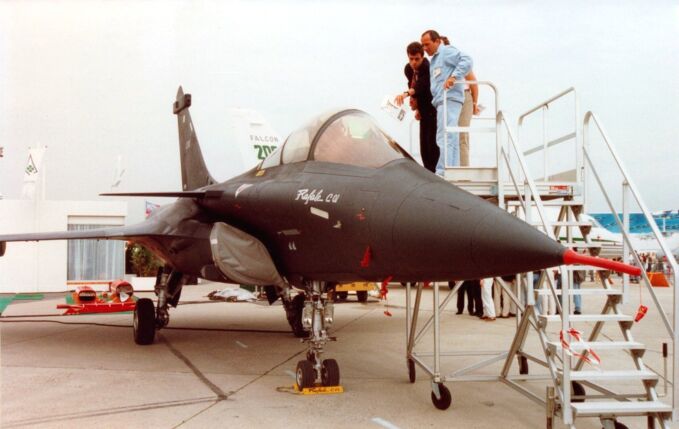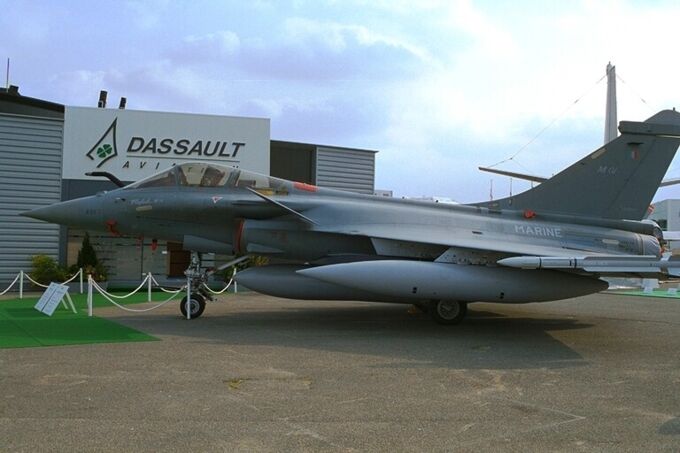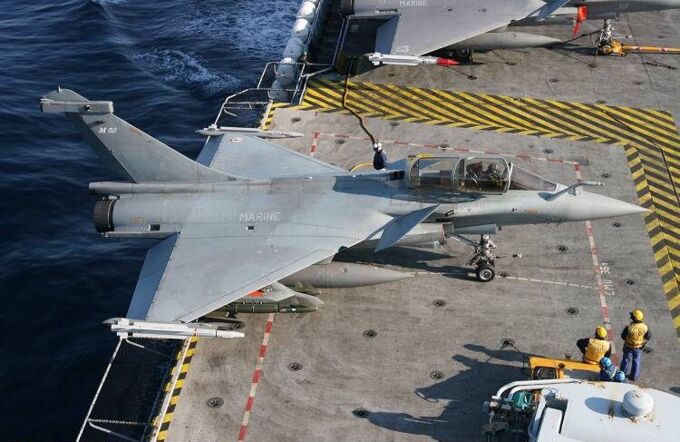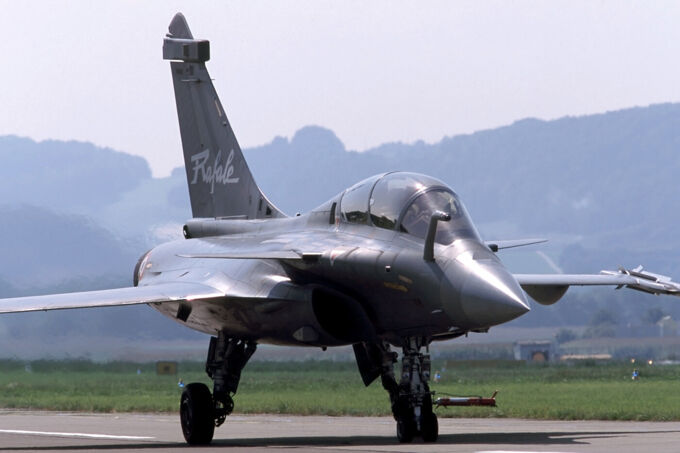The Rafale, developed by Dassault Aviation, is the centerpiece of the French Armée de l’Air et de l’Espace (Air and Space Force), and is arguably one of the best multirole aircraft in service today. However, developing such an advanced machine was no easy task. France chose to create a combat aircraft that could replace a wide array of legacy platforms, from reconnaissance and nuclear deterrence to air superiority and naval operations. The Rafale embodies the concept of, as Dassault calls it, an “omnirôle” aircraft, designed to excel in every mission, performing multiple roles in a single flight, and doing so without requiring major modifications to the aircraft itself. In this article, I will explore the history of its development, from the prototypes to the pre-production models.
(Picture by Mike Burdett, licensed under CC BY-SA 2.0, via Flickr)
The Origins:
In the late '70s, after the peak of the Cold War and the entry into service of many advanced fighters on both sides (F-15A, F-16A, Su-27 Flanker-B, MiG-29 Fulcrum-A), the French Armed Forces, more specifically the Armée de l’Air (French Air Force) and the Marine Nationale (French Navy) were looking for a new plane to modernize their fleet.
Indeed, there was a growing need to bring together all missions (such as the reconnaissance and nuclear striking capabilities of the Mirage IVA, Jaguar A/E ground attack capabilities, Mirage F1C interception capability and the Naval abilities of the Etendard IV and the F-8 Crusader) into a single aircraft that would succeed them all. Acknowledging that developing such a plane alone would be difficult, France initially turned to Europe for collaboration. Quickly, the Luftwaffe turned to France, initiating discussions aimed at eventually replacing the French Jaguars, Mirage 2000C’s and the West German F-4F Phantom II. Seeing that an agreement was being made between the two, the RAF asked to join the project, aiming to replace their Phantoms. Each country would have to give one proposal for this brand new project, known as the “European Combat Fighter” (ECF), renamed shortly after the “European Combat Aircraft” (ECA) . The first characteristics of the Rafale make their appearance: Delta wing twin-jet, canards and electric flight controls.
The French proposed the “Avion de Combat Tactique” ACT 92, by AMD-BA (current Dassault). The British proposed their “Air Staff Target” AST 403, that got replaced by the “Agile Combat Aircraft” ACA by Panavia (association between BAe, MBB, and Aeritalia). The Germans proposed their “Taktisches Kampf Flugzeug-90” TKF-90, manufactured by MBB.
Unfortunately, no agreement came from that project, as the three aircraft diverged too much for each country’s operational requirements (AMD-BA wanted a light multirole, as explained before, while BAe and MBB wanted more of a heavy long-range interceptor). In September 1982, the British MoD announced the beginning of the “Experimental Aircraft Program” (EAP) with Panavia, based on its ACA and on MBB’s TKF-90. On 13 April 1983, the French ‘Avion de Combat eXpérimental’ (ACX) project began.
During the same year, European countries made one last attempt to agree on a joint project, the “European Staff Target for a European Fighter Aircraft” (EST-EFA), joined by France, West Germany, the UK, Italy, and Spain. However, the same issues persisted. Britain wanted to use Turbo-Union RB199 engines while France wanted to stick with its SNECMA M88. AMD-BA also wanted the lead on the project. When the UK and West Germany came with a distribution for the project, where the United Kingdom asked for the technical lead, Germany for the industrial lead, and Italy for the financial lead, giving France only the presidency of this lead, an honorary title, France declined again.
“The British invited us the way one invites a turkey for Christmas.”
On 2 August 1985, Charles Hernu, France’s Minister of Defence, announced that France would not be part of the “European Fighter Aircraft” (EFA) project, along with Spain. Despite Spain choosing to rejoin the EFA project a month later, France chose to stand their ground. Just a few months later, on 13 December 1985, AMD-BA revealed in Saint-Cloud the prototype of what would become the crowning achievement of French aviation: the Rafale.
The Rafale A:
The aircraft had its first ground run-up on 10 April 1986. Since the SNECMA M88 mentioned above wasn’t ready yet, the Rafale A demonstrator was given General Electric F404-GE-100 engines, already equipping the F/A-18 Hornet at that time. On 4 July 1986, the Rafale A had its maiden flight, reaching Mach 1.3 and an altitude of 36000 ft, without afterburner. On its 93rd flight in March 1987, it reached Mach 2!
The Rafale A was first presented at the 1986 Farnborough International Airshow, along with the BAe EAP, precursor of the Eurofighter Typhoon. The Rafale was ahead, having completed more flights and putting on a far better demonstration flight than its British rival.
Fun Fact: At first, the French Navy wasn’t interested in the Rafale and planned to buy or lease around 30 F/A-18Cs for its fleet, which would be faster since the Rafale program was a long one. But after lobbying from Dassault on the government, the Navy decided to wait for the Rafale to be fully ready while upgrading some of its F-8E Crusaders and Super Etendards.
After 460 flights, the left F404 was replaced by the long-awaited SNECMA M88-2, smaller, yet more powerful and more fuel-efficient. After several flight tests, the M88 proved easier to restart in flight and overall, more efficient.
The Rafale A performed its last flight on 24 January 1994, after completing 867 flights. It now is on display in the Musée de l’Air et de l’Espace (Air and Space Museum) in Le Bourget, near Paris.
The Rafale C01:
Delivered from the Saint-Cloud factory in October 1990, the Rafale C01 is based on the production version of the Rafale C (C for “Chasse”, fighter), the single-seater version of the Rafale. It is indeed smaller, with bigger canards, a brand-new two-piece canopy, and a completely redesigned vertical stabilizer, remade to fit the future SPECTRA system. It was also equipped with two M88-2s. The nose is also lowered by 1.5° and the aircraft was now made of 50% composite materials.
Fun Fact: Another prototype similar to the Rafale C01, the Rafale C02, was planned, but the idea was abandoned in 1991 as it would have come out of the factory too late and also due to budget constraints.
The maiden flight of the Rafale C01 occurred on May 19th, 1991, and was piloted by the same test pilot who first flew the Rafale A, Guy Mitaux-Maurouard. The aircraft was first presented to the public during the 1992 Farnborough International Airshow.
Fun Fact: The Rafale C01 didn’t have any HUD until a few months after its first flight.
The aircraft flew from 1991 to 2003, completed 1287 flights, fired two Magic IIs and a few cannon shots during 10 different firing campaigns. After spending a few years in storage at Châteaudun Air Base storages, it now rests in Paris, at the French Armed Forces headquarters, since 2019. It has been repainted with the standard operational camouflage, losing its beautiful black livery.
The Rafale B01:
While the Rafale C01 and the M01 (mentioned below) aimed to develop the structure of the aircraft, the B01, precursor of the Rafale B (B for “Biplace”, Two-Seater), aimed to develop, implement, and validate some of the systems of the aircraft (flight controls, weapons systems, etc.). While we don’t know the exact date it came out of the factory (probably in 1992), we know it made its first flight on 30 April 1993, with Jean Frémond and Dominique Chevrier.
The Rafale B01 is equipped with the Martin-Baker’s MK16F ejection seat, new digital computers and has 400kg/881lbs less fuel stored inside. It saw the RBE2 Radar be implemented on 7 July 1993.
(First picture by bibi95, licensed under CC BY 2.0, via Wikimedia Commons)
The SPECTRA (“Système de Protection et d’Evitement des Conduites de Tir du RAfale”, Protection and Evasion System Against Fire Control for the Rafale), which was only added on other pre-production aircraft as a mock-up, had its first prototype finalized in early 1994. It first flew with the B01 sometime in the summer of 1994.
Fun Fact: The SPECTRA’s original name was the VMAO (“Veille Missile Avion Omnidirectionelle”, Omnidirectional Aircraft Missile Surveillance)!
The B01 integrated the MICA missile since all of the system components were present in it. The first MICA was shot on rail on June 1995, while the first MICA shot in ejection was in February 1996. It will also see the integration of the APACHE anti-runaway cruise missile, even though it was never used.
If the Rafale B01 is famous for one thing, it is probably for being the prototype that tested the Conformal Fuel Tanks (CFTs). With a capacity of 1,150 L/39.5 gal, they were tested in April 2001 and proven capable of flying supersonic. They never entered service.
Furthermore, the Topsight Helmet Mounted Visual Display was tested on the B01, as it was intended to enter service on the Mirage 2000 and the Rafale. It will be replaced by the SAGEM Gerfaut.
Even though the exact date of its last flight is unknown, we know the Rafale B01 was retired around summer 2005. It lost its camouflage paint, received the standard Rafale paint scheme, and was displayed in various locations. Since 2019, it is now exposed in the Aérocampus Aquitaine.
The Rafale M01…
Rolling out of the Saint Cloud factory on 9 December 1991, the Rafale M01 was the first pre-production Rafale M (M for “Marine”, Navy). The Rafale M01 allowed the integration of the specific constraints and features required for the naval variant. Therefore, the aircraft gets access to a reinforced structure and front landing gear (capable of withstanding an impact speed of 6 m/s) and an arresting gear. It makes the Rafale M approximately 600 kg/1,300 lbs heavier than the C variant.
Fun Fact: The Rafale M is the only Rafale with a built-in ladder. It was removed from the other versions as a cost-saving measure.
3 days later, the M01 did its first flight, piloted by Yves Kerhervé, reaching Mach 1.4 at 45,000 ft. While having good flight performances, it has a bit smaller range, speed, and a bit bigger landing distance.
The M01 underwent multiple test campaigns. The first one occurred in the United States, as the US Navy was the only one in the world with adequate infrastructure. The objective was to simulate the launch and landing on aircraft carriers. Between July and August 1992, it was catapulted 39 times and landed 69 times.
The second one, still in the United States, was to simulate launch and landing with different payloads (between 1t-5t/2,200lb-11,000lb of payload) and crosswind (up to 74km/h/46mph). Between January and February 1993, it was catapulted 42 times and landed around 60 times.
The third one was to simulate launch and landing with heavier configurations (such as air/ground configurations with 3 fuel tanks). Between November and December 1993, it was catapulted 59 times and landed 40 times.
Fun Fact: To minimize environmental impact (and save fuel), the 2,000L fuel tanks were filled with water!
And finally, the fourth and final test campaign for the M01 occurred in between November and December 1995, with basically the same objective as the third one, being catapulted 57 times and landed 63 times.
The fate of the Rafale M01 is, to say the least, rather mysterious. We know it saw its last flight around 1998. It was then stored in Istres Air Base for a while. Since 2016, it has been used for training at the École du Personnel du Pont d’Envol (EPPE) at BAN Hyères (Hyères Naval Airbase).
…and the Rafale M02!
With its first flight being on 8 November 1993 (the day the third testing campaign of the Rafale M1 began), the Rafale M02 is probably the closest a pre-production aircraft could get to the serial-production Rafale. It featured the serial cockpit, the RBE2 and SPECTRA, while having a functional OSF (“Optronique Secteur Frontal”, Front Sector Optronics).
The M02 underwent its first testing campaign on the Foch Aircraft Carrier in Spring 1994, but its most important one is probably the one on the Charles de Gaulle aircraft carrier in 1999. The M02 became the second aircraft to ever land on it, and the first one ever to be launched from it. During summer 1999, it launched and landed on it 33 times.
Image by Guillaume Rueda, licensed under CC BY-SA 3.0, from Wikimedia Commons.
Making its last flight in 2018/2019, the Rafale M02 is now resting with its brother the M01 at the École du Personnel du Pont d’Envol (EPPE).
Entering serial production
On 4 December 1998, the first serial-production Rafale, the B301, performed its maiden flight, and the Marine would have to wait a few more months to see its first serial Rafale fly, the Rafale M1, on 7 July 1999. They were both part of the first tranche of 13 Rafales ordered in 1997 by the French Armed Forces.
Despite starting later, with less funding, and being developed solely by France, the Rafale program managed to finish before the Eurofighter’s, which suffered many delays because of political disagreements, which caused the development costs to skyrocket.
(Picture by Rob Schleiffert, licensed under CC BY-SA 2.0, via Wikimedia Commons)
Sources:
- omnirole-rafale.com, probably the most complete website about the Rafale, approved by former Rafale pilots and Dassault employees.
- http://www.ffaa.net/aircraft/rafale/rafale_fr.htm.
- “Chronique du Ciel: La genèse du Rafale” by Frédéric Beniada on France Info.
- Dassault Aviation website.
- French and English articles of the Rafale on Wikipedia.
- aviationsmilitaire.net forum.
- Rafale’s A article on the Musée de l’Air et de l’Espace website.
- aviationprofilart for the preproduction and prototypes profile art.
- “Pourquoi le Rafale est il meilleur que ses concurrents?” by Jumpseat and Aerobuzz on Youtube, the main guest being François Lemainque, former expert engineer at Dassault Aviation who worked on the Rafale.
- “La folle histoire du Rafale, l’avion invendable devenu un blockbuster” by Les Echos, french Newspaper on Youtube.
- “C’est pas sorcier: Avion de chasse”, french educational program, with some informations about the Rafale B01, the TopSight helmet and Yves Kerhervé being interviewed a few times, available on youtube.
- “1985: Le Rafale, avion du futur” by the INA (Institut national de l’audiovisuel).

